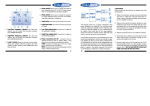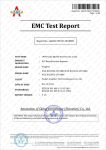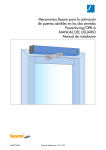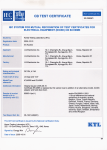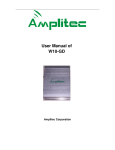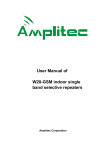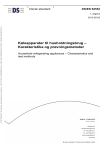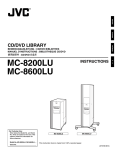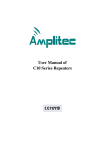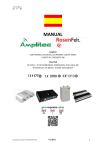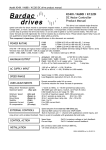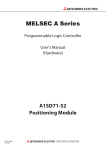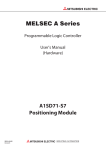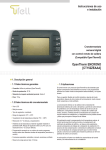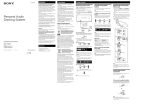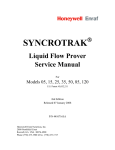Download C Model repeaters N 60950 Test Report On Amplitec Products
Transcript
TEST REPORT IEC 60950-1: 2005 (2nd Edition) and/or EN 60950-1:2006 Information technology equipment-Safety requirements Part 1: General requirement Report Reference No........................ : VITE10013NBS Tested by (+ signature)...................... : /Tony Li Review by (+ signature) : /Andy Zhang Approved by (+ signature) ................. : /Tracy Qi Date of issue ...................................... : Aug 16, 2010 Contents............................................ : Total 27 pages Attachments: Attachment A Product photos : 2 pages This report is based on a blank test report that was prepared by KEMA using information obtained from the TRF originator(see below) Testing Laboratory Name ............ : Shenzhen VITE Technology Co.,Ltd Address ........................................... : Suite 2123, Building 4, Hongfa Centre, Central Area Baoan, Baoan District, Shenzhen, Guangdong, 518101, P.R. China : Same as above. Testing location Applicant Name.................................................. : Foshan Amplitec Tech Development Co., Ltd Address .............................................. : No.1 Room,Second Floor ,No.40,First East Tonghua Rd , Foshan City , Guangdong Province , China 528000 Standard............................................. : EN 60950-1:2006 Non-standard test method ................. : N/A Procedure deviation : N/A Test procedure : CCA Copyright reserved to the bodies participating in the CENELEC Certification Agreement (CCA) Test Report From/blank test report Test Report Form No. : VITE10013NBS Test Report Form(s) Originator: VITE Master TRF : 07-06 Test item Description ........................ : Mobile Phone Signal Repeater Trademark.......................................... : Amplitec Report No.: VITE10013NBS 1 Model No............................................ : C20C-GDW, C10C/15C/20C/24C/27C/30C-EGSM C10C/15C/20C/24C/27C/30C-GSM C10C/15C/20C/24C/27C/30C-DCS C10C/15C/20C/24C/27C/30C-WCDMA C10C/15C/20C/24C/27C/30C-ED C10C/15C/20C/24C/27C/30C-EW C10C/15C/20C/24C/27C/30C-GD C10C/15C/20C/24C/27C/30C-GW C10C/15C/20C/24C/27C/30C-DW C10C/15C/20C/24C/27C/30C-GDW Manufacturer ...................................... : Foshan Amplitec Tech Development Co., Ltd Rating(s)............................................. : Input: 100-240Vac 1.6A 50-60Hz Output:12Vdc, 5.0A (by AC adapter) Particulars;test item vs.test requirements Equipment mobility : Fixed Equipment Operating condition : Continuous Mains supply tolerance : +10%,-10%(charge from a approved adapter) Tested for IT power systems : N/A IT testing, phase-phase voltage : N/A Class of Equipment : Class Ⅲ equipment Mass of equipment (kg) : 6.2kg Protection against ingress of water : IPX0 Test case verdicts Test case does not apply to the test object.................. : N(.A.) Test item does meet the requirement .......................... : P(ass) Test item does not meet the requirement .................... : F(ail) Testing Date of receipt of test item ........................................... : Aug 02, 2010 Date(s) of performance of test……………...................: Aug 09, 2010 General remarks This report shall not be reproduced except in full without the written approval of the testing laboratory. The test results presented in this report relate only to the item(s) tested. "(see appended table)" refers to a table appended to the report. “(see remark #)” refers to a remark appended to the report. Throughout this report a point is used as the decimal separator. Until otherwise specified, all tests are done under normal ambient condition 25℃±10,Max RH:75% And air pressure of 860 mbar to 1060 mbar. All models are same except the type model only. Name and address of production site (Factory): Foshan Amplitec Tech Development Co., Ltd No.1 Room,Second Floor ,No.40,First East Tonghua Rd , Foshan City , Guangdong Province , China 528000 Report No.: VITE10013NBS 2 Copy of marking plate: Mobile Phone Signal Repeater Model No.: C20C-GDW POWER: 12V ,5.0A Foshan Amplitec Tech Development Co., Ltd Report No.: VITE10013NBS 3 EN 60950-1 Clause Requirement – Test 1 GENERAL P 1.5 Components P 1.5.1 General P Comply with IEC 60950 or relevant component standard 1.5.2 Evaluation and testing of components Result - Remark Verdict Components which were found to affect safety aspects comply with the requirements of this standard or with the safety aspects of the relevant IEC/EN component standards.(see appended table1.5.1) P Components which are certified to IEC/EN and/or national standards are used correctly within their ratings, Components not covered by IEC/EN standards are tested under the conditions present in the equipment. P Dimensions (mm)of mains plug for direct plug-in N Torque and pull test of mains plug for direct plugin;torque(Nm);pull(N) N 1.5.3 Thermal controls No any thermal controls N 1.5.4 Transformers Approved power adapter P 1.5.5 Interconnecting cables Ditto P 1.5.6 Capacitors in primary circuits Ditto P 1.5.7 Double insulation or reinforced insulation bridged by components Ditto P 1.5.7.1 General See below P 1.5.7.2 Bridging capacitors N 1.5.7.3 Bridging resistors N 1.5.7.4 Accessible parts N 1.5.8 Components in equipment for IT power systems N 1.6 Power interface P 1.6.1 AC power distribution systems TN power system for power adapter P 1.6.2 Input current (see appended table 1.6.2) P 1.6.3 Voltage limit of hand-held equipment Voltage<250V P 1.6.4 Neutral conductor ClassⅢ equipment, no earth provided N Report No.: VITE10013NBS 4 EN 60950-1 Clause Requirement – Test 1.7 Marking and instructions P 1.7.1 Power rating N Rated voltage(s)or voltage range(s)(V) Result - Remark 100-240Vac(by AC adapter ) Symbol for nature of supply, for d.c. only Verdict P P Rated frequency or rated frequency range(Hz) Marked with power adapter P Rated current (mA or A) 1.6A P Manufacturer’s name or trade mark or identification mark Foshan Amplitec Tech Development Co., Ltd P Type/model or type reference C20C-GDW P Symbol for Class II equipment only Class Ⅲ equipment N Other symbols Additional symbols or markings do not cause misunderstanding P Certification marks P 1.7.2 Safety instructions P 1.7.3 Short duty cycles Equipment is designed for continuous operation N 1.7.4 Supply voltage adjustment No such devices used N Methods and means of adjustment, reference to installation instructions N 1.7.5 Power outlets on the equipment N 1.7.6 Fuse identification(marking, special fusing characteristics. Cross-reference) N 1.7.7 Wining terminals See below N 1.7.7.1 Protective earthing and bonding terminals ClassⅢ equipment, no protective earthing N 1.7.7.2 Terminal for a.c. mains supply conductors P 1.7.7.3 Terminal for d.c. mains supply conductors P 1.7.8 Controls and indicators P 1.7.8.1 Identification, location and marking P 1.7.8.2 Colours P 1.7.8.3 Symbols according to IEC 60417 N 1.7.8.4 Markings using figures N 1.7.9 Isolation of multiple power sources No direct connection to mains supply N 1.7.10 IT power distribution systems Ditto N Report No.: VITE10013NBS 5 EN 60950-1 Clause Requirement – Test 1.7.11 Thermostats and other regulating devices No thermostats or other regulating devices used inside battery pack are not adjustable during normal use N 1.7.12 Language(s) User’s manual, service manual and marking label are in English. Versions of other languages will be provided when submitted to other countries. P 1.7.13 Durability The marking withstands required tests P 1.7.14 Removable parts N 1.7.15 Replaceable batteries N Language(s) N 1.7.16 Operator access with a tool N 1.7.17 Equipment for restricted access locations N 2 PROTECTION FROM HAZARDS P 2.1 Protection from electric shock and energy hazards 2.1.1 Protection in operator access areas N 2.1.1.1 Access to energized parts N Test by inspection N Test with test finger N Test with test pin N Test with test probe P 2.1.1.2 Battery compartments N 2.1.1.3 Access to ELV wining N Working voltage(Vpeak or Vrms);minimum distance(mm) through insulation Result - Remark Only SELV circuit included (see appended table2.10.5) Verdict N - 2.1.1.4 Access to hazardous voltage circuit wining N 2.1.1.5 Energy hazards N 2.1.1.6 Manual controls N 2.1.1.7 Discharge of capacitors in equipment N Time-constant(s);measured voltage(V) - 2.1.2 Protection in service access areas N 2.1.3 Protection in restricted access locations N 2.2 SELV circuits P 2.2.1 General requirements Report No.: VITE10013NBS 42.4V peak or 60VDC are not exceeded in SELV circuit under normal operation or single fault condition P 6 EN 60950-1 Clause Requirement – Test Result - Remark 2.2.2 Voltages under normal condition(V) Within SELVD limits P 2.2.3 Voltages under fault conditions(V) Within SELV limits P 2.2.3.1 Separation by double insulation or reinforced insulation(method 1) Class Ⅲ equipment N 2.2.3.2 Separation by earthed screen (method 2) Ditto N 2.2.3.3 Protection by earthing of the SELV circuit (method 3) Ditto N 2.2.4 Connection of SELV circuits to other circuits No direct connection between SELV and any primary circuits P 2.3 TNV circuits 2.3.1 Limits See below N Type of TNV circuits No TNV circuits in the equipment N Separation from other circuits and from accessible parts Ditto N Insulation employed Ditto N Separation from hazardous voltages Ditto N Insulation employed Ditto N Connection of TNV circuits to other circuits Ditto N Insulation employed Ditto N 2.3.5 Test for operating voltages generated extemally Ditto N 2.4 Limited current circuits 2.4.1 General requirements 2.4.2 Limit values N Frequency(Hz) N Measured current(mA) N Measured voltage(V) N Measured capacitance(µF) N 2.4.3 Connection of limited current circuits to other circuits N 2.5 Limited power sources P Inherently limited output N Impedance limited output N 2.3.2 2.3.3 2.3.4 N N No limited current circuits to be evaluated Overcurrent protective device limited output Regulating network limited output under normal operating and single fault condition Report No.: VITE10013NBS Verdict No limited output device N N P 7 EN 60950-1 Clause Requirement – Test Result - Remark Verdict Output voltage(V),output current(A),apparent power(VA) - Current rating of overcurrent protective device(A) - 2.6 Provisions for earthing and bonding N 2.6.1 Protective earthing 2.6.2 Functional earthing N 2.6.3 Protective earthing and protective bonding conductors N 2.6.3.1 General N 2.6.3.2 Size of protective earthing conductors N Rated current(A),cross-sectional area (mm2),AWG - Size of protective bonding conductors N Rated current(A),cross-sectional area (mm2),AWG - 2.6.3.4 Resistance(Ω) of earthing conductors and their terminations, test current(A) N 2.6.3.5 Colour of insulation N 2.6.4 Terminals N 2.6.4.1 General N 2.6.4.2 Protective earthing and bonding terminals N Rated current(A),type and nominal thread diameter(mm) - 2.6.4.3 Separation of the protective earthing conductor from protective bonding conductors N 2.6.5 Integrity of protective earthing N 2.6.5.1 Interconnection of equipment N 2.6.5.2 Components in protective earthing conductors and protective bonding conductors N 2.6.5.3 Disconnection of protective earth N 2.6.5.4 Parts that can be removed by an operator N 2.6.5.5 Parts removed during servicing N 2.6.5.6 Corrosion resistance N 2.6.5.7 Screws for protective bonding N 2.6.5.8 Reliance on telecommunication network or cable distribution system N 2.6.3.3 Report No.: VITE10013NBS ClassⅢ equipment N 8 EN 60950-1 Clause Requirement – Test Result - Remark 2.7 Overcurrent and earth fault protection in primary circuits N 2.7.1 Basic requirements N With power supply from approved switching adaptor or secondary lithium battery, no primary circuits inside Verdict Instructions when protection relies on building installation N 2.7.2 Faults not covered in 5.3 N 2.7.3 Short-circuit backup protection N 2.7.4 Number and location of protective devices N 2.7.5 Protection by several devices N 2.7.6 Warning to service personnel N 2.8 Safety interlocks N 2.8.1 General principles 2.8.2 Protection requirements N 2.8.3 Inadvertent reactivation N 2.8.4 Fail-safe operation N 2.8.5 Moving parts N 2.8.6 Overriding N 2.8.7 Switches and relays N 2.8.7.1 Contact gaps(mm) N 2.8.7.2 Overload test N 2.8.7.3 Endurance test N 2.8.7.4 Electric strength test 2.8.8 Mechanical actuators N 2.9 Electrical insulation P 2.9.1 Properties of insulating materials Natural rubber, asbestos or hygroscopic materials are not used P 2.9.2 Humidity conditioning 48 Hours P Humidity(%) 93%RH P Temperature(℃) 25℃ P Grade of insulation Function insulation provided P 2.9.3 Report No.: VITE10013NBS No safety interlocks (see appended table 5.2) N N 9 EN 60950-1 Clause Requirement – Test Result - Remark Verdict 2.10 Clearances, creepage distances and distances through insulation N 2.10.1 General N 2.10.2 Determination of working voltage N 2.10.3 Clearances N 2.10.3.1 General N 2.10.3.2 Clearances in primary circuits (see appended table 2.10.3 and 2.10.4) N 2.10.3.3 Clearances in secondary circuits (see appended table 2.10.3 and 2.10.4) N 2.10.3.4 Measurement of transient voltage levels 2.10.4 Creepage distances N (see appended table 2.10.3 and 2.10.4) N CTI tests - 2.10.5 Solid insulation N 2.10.5.1 Minimum distance through insulation 2.10.5.2 Thin sheet material N Number of layers(pcs) - Electric strength test 2.10.5.3 (see appended table 2.10.5) (see appended table 2.10.5) Printed boards Distance through insulation N N (see appended table 5.2) N Electric strength test for thin sheet insulating material N Number of layers(pcs) N Wound components N Number of layers(pcs) N Two wires in contact inside wound component angle between 45° and 90° N 2.10.6 Coated printed boards N 2.10.6.1 General N 2.10.6.2 Sample preparation and preliminary inspection N 2.10.6.3 Thermal cycling N 2.10.6.5 Thermal ageing℃ N 2.10.6.6 Electric strength test 2.10.5.4 (see appended table 5.2) Abrasion resistance test Electric strength test 2.10.6.7 Enclosed and sealed parts Report No.: VITE10013NBS N N (see appended table 5.2) N N 10 EN 60950-1 Clause Requirement – Test 2.10.7 Temperature T1=T2+Tma-Tamb+10K(℃) N 2.10.8 Spacings filled by insulating compound N Electric strength test Result - Remark (see appended table 5.2) Verdict - 2.10.9 Component external terminations N 2.10.10 Insulation with varying dimensions N 3 Wiring , Connections and supply P 3.1 General P 3.1.1 Current rating and overcurrent protection Adequate cross sectional areas on internal wiring P 3.1.2 Protection against mechanical damage Wires do not touch sharp edges that could damage the insulation and cause hazard P 3.1.3 Securing of internal wiring 3.1.4 Insulation of conductors (see appended table 5.2) P 3.1.5 Beads and ceramic insulators No such insulators provided P 3.1.6 Screws for electrical contact pressure No electrical contact pressure by screwed connections N 3.1.7 Insulating materials in electrical connections No contact pressure through insulating material N 3.1.8 Self-tapping and spaced thread screws Thread-cutting or space thread screws are not used for electrical connections N 3.1.9 Termination of conductors All conductors are reliable secured P P 10N pull test N 3.1.10 Sleeving on wiring 3.2 Connection to an a.c. mains supply or a d.c. mains supply 3.2.1 Means of connection 3.2.1.1 Connection to an a.c. mains supply N 3.2.1.2 Connection to an d.c. mains supply N 3.2.2 Multiple supply connections N 3.2.3 Permanently connected equipment N Number of conductors, diameter(mm) of cable and conduits - Report No.: VITE10013NBS No sleeving used to provide supplementary insulation Class Ⅲ equipment, no direct connection to mains supply N N N 11 EN 60950-1 Clause Requirement – Test Result - Remark 3.2.4 Appliance inlets N 3.2.5 Power supply cords N 3.2.5.1 AC power supply cords N Type Verdict 2 Rated current(A),cross-sectional area(mm ),AWG - 3.2.5.2 DC power supply cords N 3.2.6 Cord anchorages and strain relief N Mass of equipment (kg),pull(N) - Longitudinal displacement(mm) - 3.2.7 Protection against mechanical damage N 3.2.8 Cord guards N D(mm);test mass(g) - Radius of curvature of cord (mm) - 3.2.9 Supply wiring space N 3.3 Wiring terminals for connection of external conductors P 3.3.1 Wiring terminals P 3.3.2 Connection of non-detachable power supply cords N 3.3.3 Screw terminals N 3.3.4 Conductor sizes to be connected N Rated current(A),cord/cable type, cross-sectional area(mm2) - Wiring terminal sizes N Rated current (A),type and nominal thread diameter(mm) - 3.3.6 Wiring terminals design N 3.3.7 Grouping of wiring terminals N 3.3.8 Stranded wire N 3.4 Disconnection from the mains supply P 3.4.1 General requirement P 3.4.2 Disconnect devices N 3.4.3 Permanently connected equipment N 3.4.4 Parts which remain energized N 3.4.5 Switches in flexible cords N 3.4.6 Single-phase equipment and d.c. equipment N 3.3.5 Report No.: VITE10013NBS 12 EN 60950-1 Clause Requirement – Test Result - Remark Verdict 3.4.7 Three-phase equipment N 3.4.8 Switches as disconnect devices N 3.4.9 Plugs as disconnect devices N 3.4.10 Interconnected equipment N 3.4.11 Multiple power sources N 3.5 Interconnection of equipment P 3.5.1 General requirements P 3.5.2 Types of interconnection circuits SELV circuit P 3.5.3 ELV circuits as interconnection circuits No ELV interconnections N 4 Physical requirements 4.1 Stability Hand-held equipment N Angle of 10° No hazards with overturn N Test force(N) Ditto N N 4.2 Machanical strength P 4.2.1 General 4.2.2 Steady force test,10N N 4.2.3 Steady force test,30N N 4.2.4 Steady force test,250N 250N applied to outer enclosure, No energy or other hazards. P 4.2.5 Impact test See clause 4.2.6 N See below P Fall test N Swing test N 4.2.6 Drop test No damage of the enclosure, no energy hazards or damage to enclosure integration after the test. P 4.2.7 Stress relief test 70℃.7hours P 4.2.8 Cathode ray tubes No cathode ray tube. N Picture tube separately certified (see separate test report or attached certificate) N 4.2.9 High pressure lamps No high pressure lamp N 4.2.10 Wall or ceiling mounted equipment, force(N) Hand-equipment N Report No.: VITE10013NBS 13 EN 60950-1 Clause Requirement – Test Result - Remark Verdict 4.3 Design and construction 4.3.1 Edges and corners Edges and comers are rounded P 4.3.2 Handles and manual controls; force(N) 15N press force P 4.3.3 Adjustable controls No such adjustable control. N 4.3.4 Securing of parts No loosening of parts is likely to occur. P 4.3.5 Connection of plugs and sockets P 4.3.6 Direct plug-in equipment N P Dimensions(mm) of mains plug for direct plug-in Power adapter is direct plug-in P Torque and pull test of mains plug for direct plug-in; torque(Nm);pull(N) 0.25Nm P 4.3.7 Heating elements in earthed equipment No heating elements. N 4.3.8 Batteries 4.3.9 Oil and grease No Oil and grease N 4.3.10 Dust. Powders. liquids and gases Equipment in intended use not considered to be exposed to these N 4.3.11 Containers for liquids or gases No containers for liquids or gases N 4.3.12 Flammable liquids The equipment does not contain flammable liquid N N Quantity of liquid(i) N Flash point(℃) N 4.3.13 Radiation; type of radiation N 4.3.13.1 General N 4.3.13.2 Ionizing radiation N Measured radiation(pA/kg) - Measured high-voltage(kV) - Measured focus voltage(kV) - CRT markings - Effect of ultraviolet(UV)radiation on materials N Part, property, retention after test, flammability classification N Human exposure to ultraviolet (UV)radiation N 4.3.13.3 4.3.13.4 Report No.: VITE10013NBS 14 EN 60950-1 Clause Requirement – Test Result - Remark 4.3.13.5 Laser (including LEDS) N Laser class - 4.3.13.6 Other types N 4.4 Protection against hazardous moving parts N 4.4.1 General N 4.4.2 Protection in operator access areas N 4.4.3 Protection in restricted access locations N 4.4.4 Protection in service access areas N 4.5 Thermal requirements P 4.5.1 Maximum temperatures (see appended table 4.5) Verdict P Normal load condition per Annex L N 4.5.2 Resistance to abnormal heat N 4.6 Openings in enclosures N 4.6.1 Top and side openings N Dimensions(mm) - Bottoms of fire enclosures N Construction of the bottom - 4.6.3 Doors or covers in fire enclosures N 4.6.4 Openings in transportable equipment N 4.6.5 Adhesives for constructional purposes N Conditioning temperature(℃)/time(weeks) - 4.7 Resistance to fire P 4.7.1 Reducing the risk of ignition and spread of flame Method 2 is used P Method 2,selection and application of components wiring and materials (see appended table 4.7) N Method 2,application of all of simulated fault condition (see appended table 5.3) tests P 4.7.2 Conditions for a fire enclosure P 4.7.2.1 Parts requiring a fire enclosure N 4.7.2.2 Parts not requiring a fire enclosure P 4.7.3 Materials P 4.6.2 Report No.: VITE10013NBS See below 15 EN 60950-1 Clause Requirement – Test Result - Remark 4.7.3.1 General P 4.7.3.2 Materials for fire enclosures N 4.7.3.3 Materials for components and other parts outside fire enclosures 4.7.3.4 Materials for components and other parts in side fire enclosures 4.7.3.5 Materials for air filter assemblies No air filter assemblies N 4.7.3.6 Materials used in high-voltage components No high voltage components N 5 Electrical Requirements and Simulated Abnormal Conditions P 5.1 Touch current and protective conductor current - 5.1.1 General N 5.1.2 Equipment under test(EUT) N 5.1.3 Test circuit N 5.1.4 Application of measuring instrument N 5.1.5 Test procedure N 5.1.6 Test measurements Adapter is Evaluated in this report P Test voltage(V) 240V~ - Measured touch current(mA) <0.01mA - Max.allowed touch current(mA) 0.25mA - Material for component and other parts outside fire enclosure fulfil the requirement Verdict P N Measured protective conductor current(mA) - Max.allowed protective conductor current(mA) - 5.1.7 Equipment with touch current exceeding 3.5mA N 5.1.8 Touch currents to and from telecommunication networks and cable distribution systems and from telecommunication networks N 5.1.8.1 Limitation of the touch current to a telecommunication network and a cable distribution system N Test voltage(V) - Measured touch current(mA) - Max. Allowed touch current(mA) - 5.1.8.2 Summation of touch currents from telecommunication networks N 5.2 Electric strength P 5.2.1 General P 5.2.1 Test procedure Report No.: VITE10013NBS (see appended table 5.2) P 16 EN 60950-1 Clause Requirement – Test 5.3 Abnormal operating and fault conditions N 5.3.1 Protection against overload and abnormal operation N 5.3.2 Motors N 5.3.3 Transformers N 5.3.4 Functional insulation N 5.3.5 Electromechanical components N 5.3.6 Simulation of faults N 5.3.7 Unattended equipment N 5.3.8 Compliance criteria for abnormal operating and fault conditions N 6 Connection to telecommunication networks N 6.1 Protection of telecommunication networks service persons, and users of other equipment connected to the network, from hazards in the equipment N 6.1.1 Protection from hazardous voltages N 6.1.2 Requirements 6.1.2.1 Test voltage(V) - Current in the test circuit (mA) - 6.1.2.2 Exclusions N 6.2 Protection of equipment users from overvoltages on telecommunication networks N 6.2.1 Separation requirements N 6.2.2 Electric strength test procedure N 6.2.2.1 Impulse test N 6.2.2.2 Steady-state test N 6.2.2.3 Compliance criteria N 6.3 Protection of the telecommunication wiring system from overheating N Max.output current(A) - Current limiting method - 7 Connection to cable distribution systems N 7.1 Protection of cable distribution system service persons, and users of other equipment connected to the system,from hazardous voltages in the equipment N 7.2 Protection of equipment users from overvoltages on the cable distribution system N Report No.: VITE10013NBS Result - Remark (see appended table 5.2) Verdict N 17 7.3 Insulation between primary circuits and cable distribution systems N 7.3.1 General N 7.3.2 Voltage surge test N 7.3.3 Impulse test N A Annex A, tests for resistance to heat and fire N A.1 Flammability test for fire enclosures of movable equipment having a total mass exceeding 18 kg,and of stationary equipment (see 4.7.3.2) N A.1.1 Samples - Wall thickness(mm) - A.1.2 Conditioning of samples; temperature(℃) N A.1.3 Mounting of samples N A.1.4 Test flame(see IEC 60950-11-3) N Flame A,B,C or D - A.1.5 Test procedure N A.1.5 Test procedure N A.1.6 Compliance criteria N Sample 1 burning time (s) - Sample 2 burning time (s) - Sample 3 burning time (s) - A2 Flammability test for fire enclosures of movable equipment having a total mass not exceeding 18kg, and for material and components located inside fire enclosures(see 4.7.3.2 and 4.7.3.4) N A.2.1 Samples, material - Wall thickness(mm) - A.2.2 Conditioning of samples N A.2.3 Mounting of samples N A.2.4 Test flame(see IEC 60950-11-4) N Flame A,B,C or C - Test procedure N Compliance criteria N Sample 1 burning time(s) - Sample 2 burning time(s) - Sample 3 burning time(s) - Alternative test acc. To IEC 60950-2-2,cl.4 and 8 N Sample 1 burning time(s) - Sample 2 burning time(s) - A.2.5 A.2.7 Report No.: VITE10013NBS 18 Sample 3 burning time(s) - A.3 Hot flaming oil test(see 4.6.2) N A.3.1 Mounting of samples N A.3.2 Test procedure N A.3.3 Compliance criterion N B Annex B, motor tests under abnormal conditions (see 4.7.2.2 and 5.3.2) N B.1 General requirements N Position - Manufacturer - Type - Rated values - B.2 Test conditions N B.3 Maximum temperatures N B.4 Running overload test N B.5 Locked-rotor overload test N Test duration(days) - Electric strength test:test voltage(V) - B.6 Running overload test for d.c.motors in secondary circuits N B.7 Locked-rotor overload test for d.c. motors in secondary circuits N B.7.1 Test procedure N B.7.2 Alternative test procedure; test time(h) B.7.3 Electric strength test (see appended table 5.2) N B.8 Test for motors with capacitors (see appended table 5.3) N B.9 Test for three-phase motors (see appended table 5.3) N B.10 Test for series motors N Operating voltage(V) - Annex c, Transformers(see 1.5.4 and 5.3.3) N Position - Manufacturer - Type - Rated values - Method of protection - C.1 Overload test N C.2 Insulation (see appended table 5.3) N Protection from displacement of windings (see appended table 5.2) N C Report No.: VITE10013NBS (see appended table 5.3) N 19 D Annex D, Measuring instruments for touch-current tests(see 5.1.4) P D.1 Measuring instrument P D.2 Alternative measuring instrument N E Annex E, temperature rise of A winding(see 1.4.13) N F Annex F, measurement of clearances and creepage distances(see 2.10) N G Annex G, alternative method for determining minimum clearances N G.1 Summary of the procedure for determining minimum clearances N G.2 G.2.1 Determination of mains transient voltage(V) N AC mains supply N G.2.2 DC mains supply N G.3 Determination of telecommunication network transient voltage(V) N G.4 Determination of required withstand voltage(V) N G.5 Measurement of transient levels(V) N G.6 Determination of minimum clearances N H Annex H, Ionizing radiation (see 4.3.13) N J Annex J, table of electrochemical potentials(see 2.6.5.6) N Metal used - K Annex K, thermal controls(see 1.5.3 and 5.3.7) N K.1 Making and breaking capacity N K.2 Thermostat reliability; operating voltage(V) N K.3 Thermostat endurance test; operating voltage(V) N K.4 Temperature limiter endurance ;operating voltage(V) N K.5 Thermal cut-out reliability N K.6 Stability of operation L Annex L, normal load conditions for some types of electrical business equipment (see 1.2.2.1 and 4.5.1) N L.1 Typewriters N L.2 Adding machines and cash registers N L.3 Erasers N L.4 Pencil sharpeners N Report No.: VITE10013NBS Simpson 228 (see appended table 5.3) N 20 L.5 Duplicators and copy machines N L.6 Motor-operated files N L.7 Other business equipment N M Annex M, criteria for telephone ringing signals(see 2.3.1) N M.1 Introduction N M.2 Method A N M.3 Method B N M.3.1 Ringing signal N M.3.1.1 Frequency(Hz) - M.3.1.2 Voltage(V) - M.3.1.3 Cadence; time(s),voltage(V) - M.3.1.4 Single fault current(mA) - M.3.2 Tripping device and monitoring voltage N M.3.2.1 Conditions for use of a tripping device or a monitoring voltage N M.3.2.2 Tripping device N M.3.2.3 Monitoring voltage(V) N N Annex N, impulse test generators(see 2.10.3.4,6.2.2.1,7.3.2 and clause G.5) N N.1 ITU-T impulse test generators N N.2 IEC 60065 impulse test generator N P Annex P, normative references P Q Annex Q, bibliography P R Annex R, examples of requirements for quality control programmes N R.1 Minimum separation distances for unpopulated coated printed boards(see 2.10.6) N R.2 Reduced clearances(see 2.10.3) N S Annex S, procedure for impulse testing(see 6.2.2.3) N S.1 Test equipment N S.2 Test procedure N S.3 Examples of waveforms during impulse testing N T Annex T, guidance on protection against ingress of water(see 1.1.2) N Report No.: VITE10013NBS 21 U Annex U, insulated winding wires for use without interleaved insulation(see 2.10.5.4) N V Annex V, ac power distribution systems(see 1.6.1) N V.1 Introduction N V.2 TN power distribution systems N V.3 TT power systems N V.4 IT power systems N W Annex W, summation of touch currents P W.1 Touch current from electronic circuits W.1.2 Earthed circuits N W.2 Interconnection of several equipments N W.2.1 Isolation N W.2.2 Common return, isolated from earth N W.2.3 Common return, connected to protective earth N X Annex X, maximum heating effect in transformer tests (see clause C.1) N X.1 Determination of maximum input current N X.2 Overload test procedure N Y Annex Y, ultraviolet light conditioning test (see 4.3.13.3) N Y.1 Test apparatus N Y.2 Mounting of test samples N Y.3 Carbon-arc light-exposure apparatus N Y.4 Xenon-arc light exposure apparatus N 1.5.1 P TABLE: list of critical components Object/part no. Power adapter <0.25mA Manufacturer/ Type/ Trademark model --- --- P Technical data Standard Conformity Input:100-240V~ EN 60950-1:2006 Evaluated in this report UL94 UL 50-60Hz 1.6A Output:12V PCB - - Mark(s) of V-0 5A Note(s): Report No.: VITE10013NBS 22 1.6.2 TABLE: electrical date(in normal conditions) Fuse# I U(V) rated(A) P(W) I(A) I fusa(A) -- 1.6 90 -- 1.23 -- -- 1.6 264 -- 1.32 -- -- 1.6 90 -- 1.12 -- -- 1.6 264 -- 1.22 -- Condition/status / / Note(s):-2.10.3 and 2.10.4 TABLE: clearance and creepage distance measurments Clearance cl and creepage distance dcr at/of: Up V r.m.s Required (V) (V) Cl(mm) - - - - N Cl Dcr Required dar (mm) (mm) (mm) - - - Note(s):- 2.10.5 TABLE: distance through insulation measurements Distance through insulation di at/of: U r.m.s Test voltage (V) (V) N Required di Di (mm) (mm) Note(s):- 4.5.1 TABLE: maximum temperatures P Test voltage(V) b)264V,50Hz - a)90V,60Hz Tamb1(℃) 24.3 - Tamb2(℃) 24.5 - T(℃) Allowed Maximum temperature T of part/at: Tmax(℃) a) b) PCB 48.6 75.3 120 Power supply enclosure 38.2 49.2 60 Metal enclosure of EUT 30.4 29.4 60 Power switch 22.2 20.3 60 Ambient 24.5 24.3 60 Temperature T of winding - R1(Ω) - R2(Ω) - T(℃) - Allowed Tmax(℃) Insulation - - Class Note:- Report No.: VITE10013NBS 23 4.5.2 TABLE: ball pressure test of thermoplastic parts Allowed impression diameter(mm) Part P ≤2 mm Impression diameter (mm) Test temperature(℃) Adapter enclosure 125 1.2 Note(s):- 5.2 TABLE: electric strength tests and impulse tests Test voltage applied between P Test voltage(V) Breakdown L/N and adapter enclosure 1500 No Breakdown L/N and adapter mobile 1500 No Breakdown Note(s:-) 5.3 TABLE: fault condition test N Ambient temperature(℃) - Model/type of power supply - Rated markings of power supply No. Component no. Fault S=short circuit, Fault O=open circuit -- Test voltage Test (V) time Fuse no. Result O-L=overload Note:- Report No.: VITE10013NBS 24 Attachment A Product photos Report No.: VITE10013NBS 25 Report No.: VITE10013NBS 26 -------END OF REPORT------- Report No.: VITE10013NBS 27



























